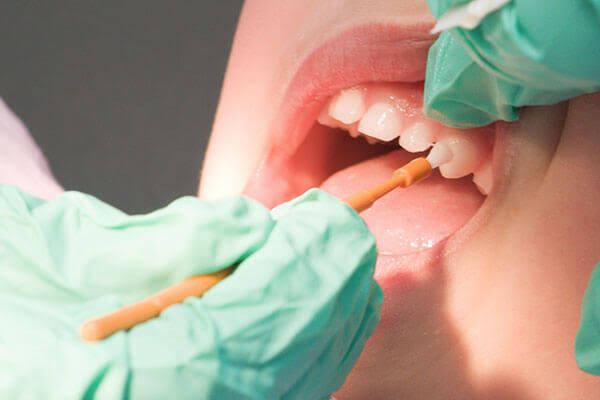Pediatric Dentistry



Regular dental check-ups help maintaining your child’s teeth and gums in a healthy condition. They also make early detection of caries possible so that minimally invasive treatment can be carried out. Your child should see a dentist every 3-6 months, depending on his/her caries risk assessment. According to American Association of Pediatric Dentistry (AAPD) it is recommended to schedule your child’s
FIRST DENTAL VISIT BY THEIR FIRST BIRTHDAY.
XRay
Our state-of-the-art X-ray machine is appealing to look at and does not invoke fear. The ultra-flexible films used ensure absolutely no or minimal discomfort for your child.


Cleaning
Cleaning (scaling) removes any plaque or tartar build up on your child’s teeth. This plaque, if not removed, is capable of causing foul breath from the mouth, yellowish discoloration of teeth, gum disease, and bone loss. If you have good oral hygiene habits and a healthy mouth, we will probably suggest professional teeth cleaning at least twice a year.
Restoration
If the decay does not involve the vital tissue of the tooth, your child might need simple fillings after cleaning the infected part of the tooth. The materials used for restoring your child’s tooth are aesthetic in colour and offer protective benefits against further caries attack.


RootCanal Treatment
Deeper infections involving the vital tissue of the tooth may call for a pulpotomy or a pulpectomy in baby teeth and root canal treatment in permanent teeth. These essentially remove the infection along with a part or the entire pulp (nerve tissue) of the tooth, followed by its replacement with a suitable medicament and restoration.
Crown
A dental crown is a tooth-shaped “cap” that is placed over a tooth to cover the tooth and restore its shape, size, strength, and in most cases, its appearance. The placement of crowns is essential for the success of root canal treatment. Root canal-treated teeth become brittle and are more prone to fracture. The placement of crowns prevents fracture of these teeth due to biting pressure. A wide variety of crowns are available and can be chosen by your dentist as per your needs.


Extraction
A tooth extraction or removal may be required if the decay has become so intense that it can’t be saved by a filling or root canal treatment. This is the last resort to help prevent the further spread of infection. We might also need to remove your teeth as part of the orthodontic work. Extraction is carried out under local anaesthesia, which puts your tooth to sleep so it can be comfortably removed.
Space maintainer
Baby teeth are important for the development of teeth, jaw bones, and muscles and help to guide permanent teeth into position. The adjacent teeth can shift into the open space created by the premature loss of a baby tooth and close or decrease the space. As a result, the permanent tooth does not find adequate space for eruption leading to malalignment of teeth. A space maintainer is an appliance that is custom-made according to each patient in case a baby tooth has been lost prematurely. It can be either removable or cemented in the child’s mouth. Its purpose is to maintain the space for the permanent tooth to erupt into its normal place. Not every child who loses a baby tooth early requires a space maintainer; however, a professional consultation with your dentist should be conducted to determine if using a space maintainer is needed.



Kids love to play, and we love to watch them playing and enjoying themselves. But sometimes this may cause injury to the teeth, which needs to be supervised and treated immediately by a dentist. They often occur after a fall, motor vehicle accident, sports injury, or fight. Injuries to the teeth and mouth can also have long-lasting effects on the child’s appearance and self-confidence. Such injuries might range from the chipping of a small part of a tooth to the complete loss of the tooth from the mouth. In case of any injury, visit us as soon as possible, as reporting an injury early to the dentist can help save your tooth’s vitality.
Habit Correction
Many children have the habit of thumb sucking, mouth breathing, tongue thrusting, etc. It is important to understand the cause of such habits and then to intercept them. This prevents the development of any malocclusion or abnormal jaw growth. Habits, if not corrected early, can become fixed and be more difficult to treat in later life.



In older children and adults, sports injuries are common. Injuries to the teeth are among the most common types of sporting injuries. Mouth injuries can cause teeth to become cracked, broken, or knocked out. It is important to see a dentist because, if left untreated, a dental emergency can lead to serious complications. Many such injuries can be prevented simply by the use of helmets, mouth guards, and other protective gear. Contact us in case your kids play any sport, especially contact sports, so we can help them prevent such injuries.

Bruxism is a condition in which your child grind or clench their teeth unconsciously when they are awake (awake bruxism) or during sleep (sleep bruxism). This can lead to flat and fractured teeth which can expose deeper layers of the teeth. Long-term bruxism can lead to increased tooth sensitivity, tight jaw muscles and can even cause locked jaw. Night guards are an effective way to control bruxism and your dentist can help in customizing night guard for your child to protect the teeth.



The biting surface of a tooth naturally has small holes (pits) and grooves (fissures).Much of the decay encountered by school-aged children occurs in these pits and fissures, as they act as ideal sites for food lodgement which eventually harbour bacteria. Sealants are an effective and painless way of protecting your child’s teeth from decay by providing a protective coating on the tooth surface.This forms a hard shield that keeps food and bacteria from getting into the tiny grooves in the teeth and causing decay. Sealants are only applied to the back teeth-the molars and premolars. Sealants are usually applied as soon as the first permanent teeth start to erupt. This is usually between 6 to 7 years of age. The rest are often sealed as soon as they appear, which can be any time between 11-14 years of age. After a thorough examination, we can let you know which teeth should be sealed.Some teeth naturally have deep grooves, which will need to be sealed;others have shallow ones, which will not need sealing.
Fluoride Application
The American Dental Association (ADA) recommends a professional fluoride treatment at the dentist’s office every 3, 6, or 12 months, depending on your oral health. Fluoride works by restoring minerals to tooth surfaces where bacteria may have eroded the enamel. It can also inhibit the growth of harmful oral bacteria and further prevent cavities. The earlier children are exposed to fluoride, the less likely they are to develop cavities. A large study found that children and adolescents who received fluoride treatments for one year were 43 percent less likely to have tooth decay and cavities.

Root canals are a commonly performed procedure in both children and adults, as baby teeth are just as prone to cavities as adult teeth. Preserving baby teeth is essential for proper oral development and alignment. Pediatric dentists are trained to address such cases, ensuring a child’s dental health and overall well-being.
Baby root canals, also known as pulpectomy, are considered safe dental procedures when performed by trained pediatric dentists. They are designed to save baby teeth and prevent pain or infection. To enhance the safety and comfort of young patients receiving this treatment, pediatric dentists utilise specialised techniques and materials.
Baby root canals, also known as pulpectomy, are generally not painful. Pediatric dentists use local anaesthesia to numb the area, ensuring the child feels minimal to no discomfort during the procedure. These treatments aim to relieve any existing pain or infection in the baby tooth while preserving its normal function.
Pediatric dentistry is where stainless steel crowns are most frequently used. They are durable and cost-effective, making them suitable for restoring and protecting baby teeth that have extensive decay or damage. Stainless steel crowns are a common choice for maintaining the function and integrity of primary teeth in children.In pediatric dentistry zirconia and stainless steel crowns are most commonly used . Both are durable and they help in restoring function and integrity of baby teeth that had extensive decay or damage. Zirconia crowns are aesthetically superior to stainless steel crowns as they are tooth coloured.
Polycarbonate crowns in pediatric dentistry are typically used as temporary crowns for primary (baby) teeth. These crowns are tooth-coloured and more aesthetic than stainless steel crowns. They provide short-term protection and function while maintaining a natural appearance, making them suitable for anterior (front) teeth in children.
Yes, children can use night guards if recommended by a dentist. Night guards can be beneficial for children who grind their teeth (bruxism) or tighten their jaws during sleep, as they help protect teeth from damage and ease associated discomfort. A pediatric dentist can offer advice on how to utilise them.
Children can typically start getting dental X-rays around the age of 5 to 6, depending on their dental development and individual needs. X-rays help dentists assess oral health, detect cavities, and monitor tooth development. Dentists use low-dose X-rays and protective equipment to ensure safety during the procedure.
The number of dental X-rays considered safe for kids. The number and type of X-rays are determined by the child’s specific dental condition, with a focus on minimising radiation exposure to ensure safety for even the youngest kids.

